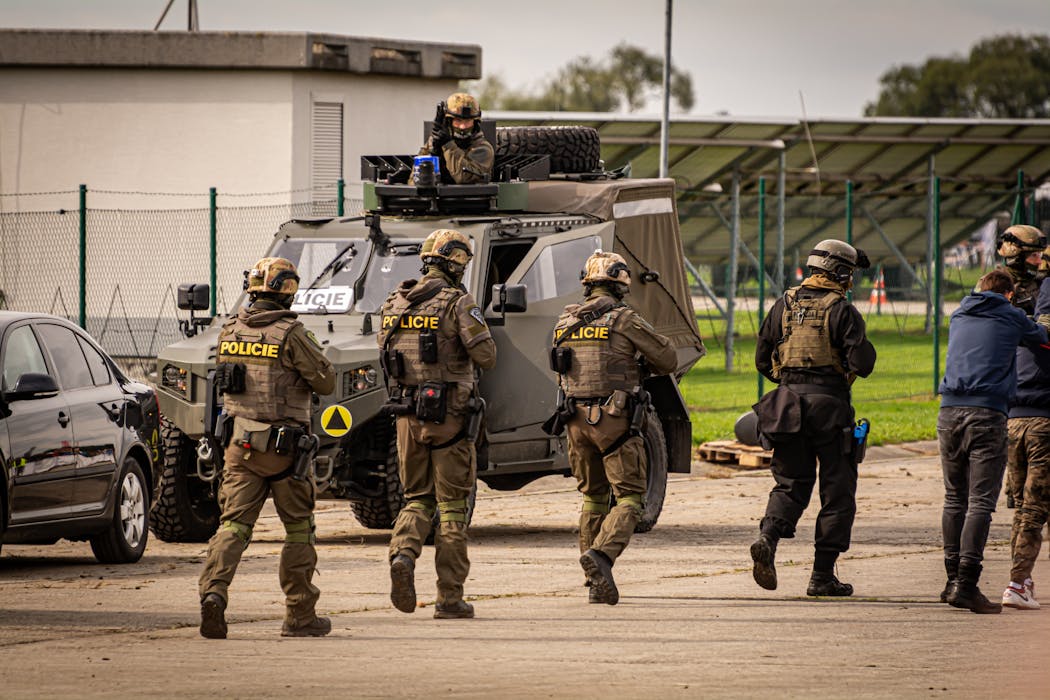Source: The Conversation – UK – By Natalia Zwarts, Research Leader in Wargaming at RAND Europe, RAND Europe

Consider the following scenario. There’s a ransomware attack, enhanced by AI, which paralyses NHS systems – delaying medical care across the country.
Simultaneously, deepfake videos circulate online, spreading false information about the government’s response. At the same time, a foreign power quietly manipulates critical mineral markets to exert pressure on the economy.
The scenario is not just a theory. It is a situation waiting to be rehearsed. And research suggests an old tool called wargaming – an exercise or simulation of a threatening situation – provides the method to do exactly that. Researchers are indeed calling for a new research agenda for experimental design for such games, applied to modern scenarios.
In a world of compounding crises, the UK government has published its first-ever chronic risks analysis, delivering a stark warning. It says the threats of the 21st century are already here and they’re deeply interconnected.
From AI-driven cybercrime to biodiversity loss and demographic shifts, the report maps 26 chronic risks that are slowly eroding national security, economic resilience and social cohesion.
The analysis rightly calls for a broader response, urging collaboration across government, industry, academia and society at large.
If chronic risks are the century’s slow burns, then wargaming is the fire drill we haven’t run. In brief, wargaming is a centuries-old tool to explore “what if” scenarios by simulating real-world crises.
In a wargame, participants take on roles, usually in opposing teams, and make decisions in response to unfolding events. Depending on the scenario, participants are recruited to act in a way that would be characteristic for the military, government, industry or humanitarian organisations.
By revealing gaps, stress points and unexpected outcomes, wargaming helps decision-makers plan smarter and respond faster when the real thing hits. Ignoring these feedback loops risks turning slow moving challenges into sudden, systemic shocks.
Historically limited to traditional warfighting, it increasingly offers a way to stress-test systems against cascading threats, from resource scarcity driving geopolitical tensions to digital exclusion fuelling misinformation.
Beyond war
Wargaming is still popular among organisations across the world. The Pentagon uses red team exercises to anticipate hybrid warfare. Red-teaming includes modelling of the adversary and attempting to predict their reasoning, planning and actions.
Nato’s “locked shields” exercises simulate cyberattacks on critical infrastructure. And the EU runs tabletops, exercises that help help stress-test defence capability development plans.

wikipedia, CC BY-SA
Developments in AI have recently been translated into gaming techniques. The Rand corporation has run wargames on issues from anti-microbial resistance to climate change.
Singapore has used wargaming to test urban development policies involving climate adaptation, transportation and population growth.
At a recent Rand Europe wargame examining the governance of AI in healthcare, players were asked to act as policymakers deciding whether to impose strict, moderate or minimal regulation on new AI tools such as automated transcription of doctor visits. They had to balance this with concerns about safety, privacy and equitable access.
The game illustrated how competing priorities, such as innovation speed versus regulatory oversight, shape real-world decisions. Despite the complexity of the topic, participants typically reached a consensus within minutes, revealing not only preferred policies but also the trade-offs that were revealed under pressure. The results of the game showed that regulation has to adapt to emerging risks, rather than be rigid.
Exercises like this demonstrate how wargaming can expose underlying assumptions and offer policymakers, practitioners and the public a structured way to debate difficult choices before or as they appear in the real world.
Depending on the scope of the game, you could choose to play one round or scenario, or extend it to more in-depth questions. The game results are the most relevant for those who will have to make such decisions, but it’s also very telling to provide them with pathways chosen by the public.
So what games should we be playing? The rapid evolution of crypto-based scams could be explored through a matrix game that includes financial regulators, banks and tech companies. A matrix game allows for a quick role-play of specific agendas with proposed actions judged by an expert facilitator. Participants would be divided into groups of criminals, law enforcement, industry and financial sector. They would then simulate a scenario where fraud spreads faster than enforcement can respond, revealing regulatory blind spots and communication failures.
In another exercise, policymakers could model how a terrorist group might weaponise AI-generated deepfakes. Participants from law enforcement, public health and social media platforms would need to determine how quickly they could identify and respond to the threat while maintaining public trust.
A third scenario could focus on geopolitical competition over critical minerals. A simulated trigger event involving European, Chinese and African actors would allow players to explore the impacts on trade policy, infrastructure security and diplomatic engagement.
These simulations would not predict the future, but would reveal how different people might behave when systems come under stress. Indeed, research into wargaming shows that while these tools aren’t perfect, they are extremely useful.
Wargaming offers a range of techniques suited to different risks. Matrix games allow multiple actors to make decisions in an evolving scenario. This makes them ideal for exploring uncertainty and conflicting interests. Red teaming helps organisations see their systems from the perspective of an adversary, exposing vulnerabilities that may go unnoticed in internal assessments. And tabletop exercises can help policymakers trace the second- and third-order effects of a crisis.
We conduct fire drills, flood drills and emergency alerts for physical disasters. It is time we have more opportunities to do the same for digital blackouts, deepfake terrorism and financial manipulation. These risks are not theoretical. They are already beginning to reshape our world – governments must take heed.
Reports like the chronic risks analysis are vital for naming and describing the dangers ahead. But they must be matched with tools that prepare us to navigate them. Wargaming gives us a chance to practise the future — to uncover the gaps in our systems, to rehearse our collective response, and to build the resilience we will need in the years to come.
We might not be able to predict the future perfectly given the speed of change. But we can test the options for potential futures. Wargaming is how we start.
![]()
The authors do not work for, consult, own shares in or receive funding from any company or organisation that would benefit from this article, and have disclosed no relevant affiliations beyond their academic appointment.
– ref. Wargaming: the surprisingly effective tool that can help us prepare for modern crises – https://theconversation.com/wargaming-the-surprisingly-effective-tool-that-can-help-us-prepare-for-modern-crises-266907








